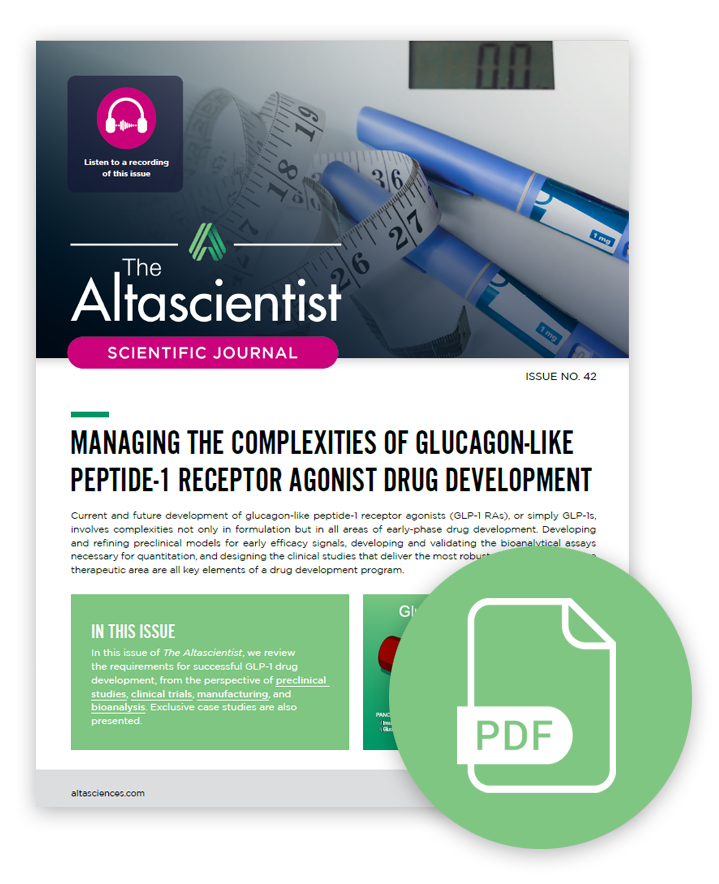ISSUE NO. 42 — Managing The Complexities of Glucagon-Like Peptide-1 Receptor Agonist Drug Development

Current and future development of glucagon-like peptide-1 receptor agonists (GLP-1 RAs), or simply GLP-1s, involves complexities not only in formulation but in all areas of early-phase drug development. Developing and refining preclinical models for early efficacy signals, developing and validating the bioanalytical assays necessary for quantitation, and designing the clinical studies that deliver the most robust data in this innovative therapeutic area are all key elements of a drug development program.
In Issue 42 of The Altascientist, we review the requirements for successful GLP-1 drug development, including:
- preclinical approaches
- early-phase clinical study design
- bioanalytical techniques
- manufacturing
Two case studies are also included.
The Golden Era of GLP-1 Drugs
GLP-1 RAs are entero-pancreatic hormone-based treatments, first approved in 2005 for type 2 diabetes (T2D), and now commonly prescribed for weight loss and reduction of atherosclerotic cardiovascular (CV) risk in patients with T2D.
According to a MarketsandMarkets report from July 2024, the global GLP-1 market is expected to reach $471 billion worldwide by 2032. More than one billion people worldwide are living with obesity, which increases their risk of major health complications, including T2D, high blood pressure, heart disease, stroke, metabolic syndrome, fatty liver diseases, some cancers, kidney disease, breathing problems, and sleep apnea. Most of these diseases are interrelated, with glycemic control and weight loss being a major factor in improving the overall health of sufferers.
“As we learn more about GLP-1 RAs, we realize that they target many organ systems, including the pancreas, the stomach, brain, heart, kidneys, immune system (due to reduced inflammation), and skeletal muscle. They help control the metabolism of white and brown adipose tissue and show positive effect in fatty liver disease (nonalcoholic steatohepatitis, or NASH),” says Dr. Gaetano Morelli, Chief Medical Officer at Altasciences.
What We Know So Far About GLP-1 RAs
GLP-1 RA head-to-head clinical studies have demonstrated that all GLP-1 RAs are effective at reducing A1C (the average amount of glucose in a person’s blood over the past three months). The initial pivotal studies that led to the first wave of GLP-1 RAs demonstrated that they work in several ways, including stimulating insulin release, slowing digestion, reducing appetite, and inhibiting glucagon release. These actions have made GLP-1 RAs excellent candidates for obesity treatment, where much of the new development is now focused. As with most medical breakthroughs, the development and implementation of GLP-1 RA drugs is not straightforward.
How Altasciences Can Help With Your GLP-1 Drug Development
Altasciences offers comprehensive services and support throughout the early phases of your GLP-1 RA drug development. We bring you expertise in preclinical studies, including custom diet-induced obesity (DIO) and other modified models; clinical trial design, conduct, and reporting; regulatory support; and bioanalytical testing.
With proactive communication and seamless handoffs, we ensure that your GLP-1 RA drug development program or study is efficiently managed. This includes optimizing study designs, managing compliance with regulatory standards like GLPs, and ensuring timely data collection and analysis. Such seamless coordination accelerates timelines, reduces costs, maximizes animal and participant safety, and ensures that the data meets the stringent requirements for regulatory approval.
Explore all issues of The Altascientist in our Resource Center. And don’t forget to subscribe to “The Altascientist: Audiobooks” on Spotify, Apple Podcasts, or wherever you get your audio content.